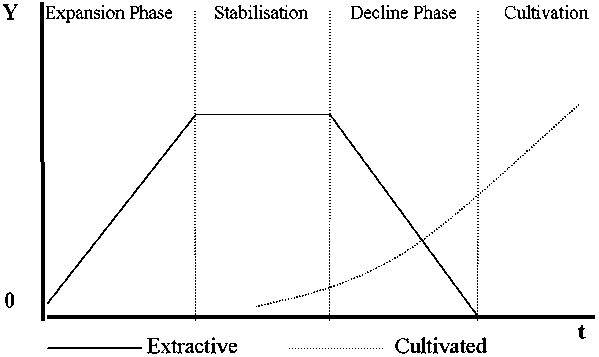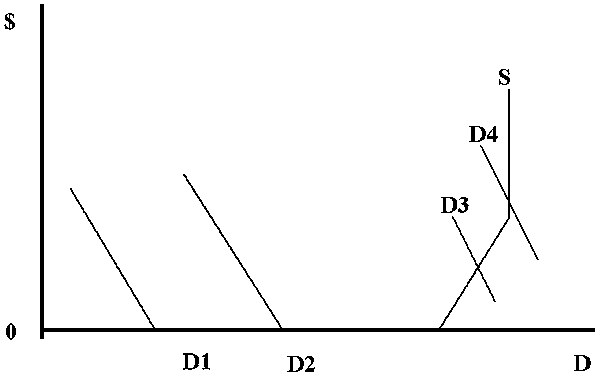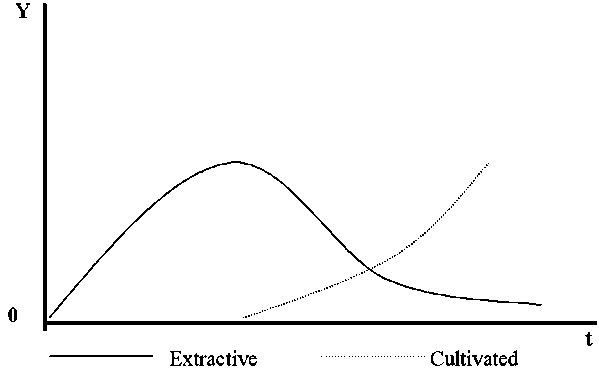

0758-A1
Vag-Lan Borges[1]
This article is an attempt to refute Alfredo Homma's model for the analysis of the extractive economy of the Amazonia. In the first part it explains the theoretical background of Homma's model. In the second part it describes the model formulated by Homma to argue that the extractive economy is not viable in long-term and that it is doomed to disappear. And it concludes that as a silvicultural and agricultural model, this theory cannot be used to explain forestry in native tropical forests.
During the last half of the eighties appeared in Brazil a new scientific paradigm of sustaining management of forest resources in the Amazon.
For having defended as a Doctoral thesis in 1986 by the University of Viçosa, Brazil, Homma's Model became the reference to analysis the emerging issue related to the economy of non-timber forest products in the Amazonia.
For Alfredo Homma, the management of non-timber forest products (NTFP) is innocuous because sooner or later these products will give way for domesticated, synthesised or any else substitute product Homma 1992a, 1992b, 1993, 1994, 1995, 1996.[2]
This article aims show some fundaments of the Homma's Model and present a new perspective to understand and assess this economic problem.
The backgrounds of the Homma's Model are based on (1) the theory of non-renewable resources of Harold Hotelling (1931) and the theory of agriculture modernisation induced by technology innovation of Hayami & Ruttan (1971).
During the first half of the XX° Century, Hotelling modelling (1931) did not address conservation of biodiversity of forest resources, but assure optimal rate of substitutability and the discount rate of non-renewable resources, which was the principal source of raw-material at that moment (specially the minerals such as petroleum, iron, gold, zinc, led, coal, silver, copper). These are products for that there isn't possibility to make renewable. Once exhausted the natural stock, this is over.
The second point of sustaining of the Homma's modelling is the famous theory of Ruttan and Hayami on the increasing returns and productivity in agriculture.
According to this theory the increasing agriculture productivity is the response to the scarcity and the marginal decreasing of the land returns of David Ricardo. Therefore, the domestication and cultivation of extractive forest products may solve increasing scarcity of forest products[3] (or extractive products).
This model of Homma presents at the same time two fragilities. First, he uses a model to assess the allocation of non-renewable to explain the management of renewable resources.
Second, he uses an economic model to assess agriculture modernisation to analysis forestry. Therefore, Homma considers that silviculture or agriculture will solve a major part of forestry problem.
To illustrate his model he makes use of the book of Genesis and remember that the apple collected by Eve in the Paradise were fruit of an extractive practice. Thence, that today apple is produced in large scale by agriculture technology of high productivity.
Thus, the argument of Homma is simple, clear, and direct: some day ago all agriculture product were an extractive product, like the apple of Eve, and for its increasing scarcity, it was domesticated and planted in a large scale or it was substituted for another product. Therefore, according to the logic of argument of Homma, orange, apple, pineapple, prickly pear, peach, and watermelon were forest products.
Are basically these premises that leads Homma argue that all forest products of native forests were or may be substituted by like-product, managed in better conditions of productivity, production, cost of production and quality.
In general, the non-timber forest economy has still yearned few interest for the part of economists and economics sciences. Few economists that dedicated to study non-timber economy make it having as an assumption the validity of the Homma's model and reaffirm his premises.
In a truth, Homma fits the reality in a pre-moulded model. His model is a deliberated effort to apply the Hotelling's model (1931) to the of the management of non-timber forest products. This model was formulated by the observation of the allocation of non-renewable resources such as the minerals.
Homma's model has as backgrounds three premises:
Premise 1 - due to its low density in the forest, and low relative productivity and production compared to large scale agriculture, the non-timber forest product will not get compete with your like-product once that always will be costs of production and market prices higher;
Premise 2 - as, following the enunciated of the Homma's model, only there is a demand segment willing to consume that kind of product, the non-timber forest product will be always substituted by a similar; and
Premise 3 - if the NTFP does not get to compete with the similar, the production will entry into stagnation and decline, making the extinction of the supply (See below the cycle of a non-timber forest product according to the Homma's model).
(Fig. 1)

Source: Homma (1996). The historical cycle of forest production in the Amazon
According to this Homma's model, extractive production of a forest product grows until get the maximum yield of the natural stock. In this stage, the price begins to grow exponentially, which induces the domestication and cultivation, the synthesising or the substitution for a like-product.
The Achilles' hell of the Homma's model is the second premise: only there is one kind of demand for each NTFP. This is the fragile point of the model.
This premise is not clear in his model, but according to Figure 1 and to excerpt below of article of him (Homma, 1992), it is possible conclude that he considers only one kind of demand for each NTFP.
With the growth of the market, the demand curve (D1, D2, D3, D4) gradually moves towards the right, making the price paid positive in order to guarantee supply of the product. Since a characteristic of extractive resources is that their supply is established by nature, the capacity of supplies reaches a certain limit where increase in price do not correspond to proportional increases in the quantity extracted or greater extraction effort do not increase the amount extracted. (Homma, 1996)
The final phase of the extractivism may be interpreted is caused by the exhaustion of the natural resources or the rigidity of the supply.
In the case of the extractivism of destruction the supply (S) curve moves toward the left, due to reduction in the source of supply. This lead to a consequent rise in prices at each level of balance in the long term, due to lack of attention to the exigencies of demand (D1, D2), given the rigidity of prices from the point where greater increases will not be supported (Homma, 1996).
In the case of extraction by gathering, the end point is reached when the supply curve becomes ineslatic, when prices have reached levels which are so high that growth of demand (D3, D4) leads to domestic forms being encouraged and extractive species are abandoned, substituted by the discovery of synthetic substitutes (Homma, 1996).
(Fig. 2)

Source: Homma 1995. Evolution of a extractive product in the market
The third and last premise of the Model, which close the logical sequence of the argument, only is true if the second premise, quoted above, is also true. It is say, the demand for a NTFP only will disappear if it competes for a same demand segment of a like-product with better market acceptability.
These three premises, once true, lead to the final affirmation of the model: the extractive economy is a cyclic economic activity composed by four phases: expansion, stagnation, decline, and extinction, as may be seen by the Figure 1.
In my view, plant extractivism constitutes a rather weak basis for development, one that finds its justification in the level of poverty of the inhabitants and the market for marginal manpower. It is an economy that is dying out, doomed to disappear, faced with an increasing market for processed products, salary policies vis-à-vis low soil and manpower productivity, population growth, the appearance of other factors (Homma, 1995).
In this same article of 1995 Karl Marx inspires Homma to close his argument on the end of the extractivism:
The extractivism economy carries within itself the very seeds of its own destruction (Homma, 1995).
Observing the behaviour and performance of the non-timber forest products in the time, by analysis time series of official data of Brazilian government, one perceive that empirical evidences do not corroborate the second premise of the Model, which is the principal pillar of sustaining of the modelling (Pastore Jr. & Borges, 1998).
By reaching the maximum yield and/or the market creates other alternatives of raw-material substitutable, the demand for a specific NTFP begins to decrease, as can be observed by graph formulated by Homma and reproduced here as Figure 1. But the production of the non-timber forest product does not reach the zero. What means that the substitutability between a non-timber product and its just substitute is not quite.
If substitute products respond to expectations of some demand segments, it is not possible to assure that will respond for all, evidencing thus the existing of diverse demand segments. One can conclude that non-timber forest products have specific qualities, which differ them within market context.
Has been various motivation for the allocation of NTFP even in an adverse context: costumes, habits, culture, accessibility etc. (Pérez 1995, Arnold & Pérez 1995). It expresses that there are various demand niches which will to pay more for specific qualities of a non-timber products, independently there be the so called substitute products (cultivated, synthesised or industrially processed). These factors lead to the deduction that for these markets one non-timber products does not compete with another similar.
Meanwhile, for many NTFP, such as rubber (Hevea brasiliensis), babassu-nut (Orbygnia phalerata), andiroba (Carapa guianensis), palha-de-piaçaba (Leopoldinia piassava), copaíba (Copaifera reticulata), is not possible verify the extinction phase, which would express the full validation or falsification of the Model. Empirically, one can see this Model has not worked at all, although there is a high level of substitutability between cultivated and synthesised products and the native ones. But, continue to exist demand segments or market niches willing to consume NTFP (Borges 2000, 2001, 2002).
Figure 3 shows, after native extraction gets maximum yield, and although cultivation grows simultaneously, native extraction goes on too. It occurs because the demand becomes segmented and makes substitutability not quite.
It leads us affirm that for some consumers Malaysian natural rubber from cultivation and the Amazonian rubber, from rainforest, are not substitutable; they compose different demand segments and therefore they cannot be understood as products that compete one another.
More recently have appeared new market niches willing to purchase NTFP. They are the "green" and "organic markets". The "green markets" expresses the group of consumers which will to pay more for products that contribute to conserve ecology; and the "organic markets" expresses the group of consumers - firms and individuals - which demand products from native source, big genetic variability, and free toxic-management based (Borges 2002).
By analysing these new niches, one can conclude that (1) although supply rigidity of non-timber forest products imply the substitutability for some demand segments, remain other segments able to buy them, since these products respond market expectations concerned to quality, quantity, supply normality and price. (2) If in a first time the production of a non-timber product can fall when beginning the competition of a similar, this product can be again replaced in the market, in the proportion that one search to attend niches still able to consume them (Borges 2001).
Our main conclusion is that there are demand segments or market niches created spontaneously for NTFP, independently the existence of like-product with lower cost of products.
This economic evidence created by the new trends of the forest markets refutes the Hommas's model. Once the substitutability is not quite, the non-timber production does not disappear.
(Fig. 3)

Relation between native production and cultivation production
The Homma's model is very important to understand how agricultural economics see and theorise forestry. But this model cannot help us assess a new forestry where the benefits are the trees and not uniquely the timber. This is the principal limitation of silvicultural models, which are generally still used to assess the management of forests to understand conservation and sustainable management of renewable resources.
Arnold, J.E. Michael & Perez, Manuel Ruiz 1995. "Framing the Issues Relating to Non-Timber Forest Products Research". In: Pérez, M. Ruiz & Arnold, J.E.M. (Ed.). Current Issues in Non-Timber Forest Products Research. Proceedings of the Workshop Research on NTFP. Hot Springs, Zimbabwe, 28 August - 2 September 1995. Cifor, Indonesia.
Borges, Vag-Lan 2000. "Sustaining non-timber extraction". TFU 10(3). ITTO, Japan.
Borges, Vag-Lan 2001. Non-timber forest products in the Amazon and markets. Non-Wood News Bulletin. FAO, Italy.
Borges, Vag-Lan 2002. Market mechanisms for non-timber forest products in the Amazon. Verweij, Pita (Ed.). Innovative Financing Mechanisms for Conservation and Sustainable Forest
Management. ETFRN News Nr. 35 2001/2002, Tropenbos, Netherlands.
Homma, Alfredo K. O. 1992a. The dynamics of extraction in Amazônia: a historical perspective. Advances in Economic Botany 9: 23-31.
Homma, Alfredo K. O. 1992b. A (ir)racionalidade do extrativismo vegetal como paradigma de desenvolvimento agrícola para a Amazônia. In: Costa, J.M.M. (Coord.). Amazônia: desenvolvimento ou retrocesso, pp. 63-207. Coleção Amazoniana, 2. CEJUP, Belém.
Homma, Alfredo K. O. 1993. Extrativismo Vegetal na Amazônia: limitações e possibilidades. Brasilia, Embrapa-SPI, Brasília, DF.
Homma, Alfredo K. O. 1994. Plan extractivism in the Amazon: limitations and possibilities. In: Clüsener-Godt, M & Sachs, I (Eds). Extractivism in the Brazilian Amazon: perspectives on regional development. MAB Digest, UNESCO, Paris, 18:34-57.
Homma, Alfredo K. O. 1995 "Modernisation and Technological Dualism in the Extractive Economy in Amazonia". In: Pérez, M. Ruiz & Arnold, J.E.M. (Ed.) 1995. Current Issues in Non-Timber Forest Products Research. Proceedings of the Workshop Research on NTFP. Hot Springs, Zimbabwe, 28 August - 2 September 1995. Cifor, Indonesia.
Homma, Alfredo K. O. 1996. Utilization of Forest Products for Amazonian Development: Potential and Limitations". In: Lieberei, R., Reisdorff, C & Machado, A. D. Interdisciplinary Research on the Conservation and Sustainable Use of the Amazonian Rain Forest and its Information Requirements. Report on the Workshop held in Brasilia, Brazil, November 20-22, 1995. Hamburg, Germany.
Hotelling, Harold 1931. "The Economics of Exhaustible Resources". Journal of Political Economy, 137-175.
Hayami, Y. & Ruttan, Vernon W. 1971. Agricultural Development: An International Perspective. John Hopkins University Press, Baltimore, USA.
Pastore Jr. & Borges, Vag-Lan 1998. Non-Wood Forest Products in the Amazonia: Collection, Processing, and Trade. Executive Summary. ITTO, Japan.
Pérez, M.R. 1995. A Conceptual Framework for CIFOR's Research on Non-wood Forest Products. Working Paper No. 6, CIFOR, Bogor.
Ros-Tonen, Mirjam A.F. 1999. Refining concepts, objectives and research questions for NTFPs Research. In: Ros-Tonen, Mirjam. NTFP research in the Tropenbos programme: Results and perspectives. The Tropenbos Foundation, The Netherlands.
| [1] Av. Taubaté, 878,
Jardim Paulista - Cep 77.600-000 - Paraíso do Tocantins - TO - Brazil. Tel: 00-55-63-602-4227; Mobile: 00-55-63-9976-5264; Email: [email protected] [2] In all these publications Homma defends the same model using the same premises [3] Our definition of NTFP excludes "products of forest origin which were cultivated in home gardens and agroforestry systems, although we pointed out that "in practice, the distinction between 'wild' and (semi-)cultivated products is often difficult to make.", See Ros-Tonen 1999. |